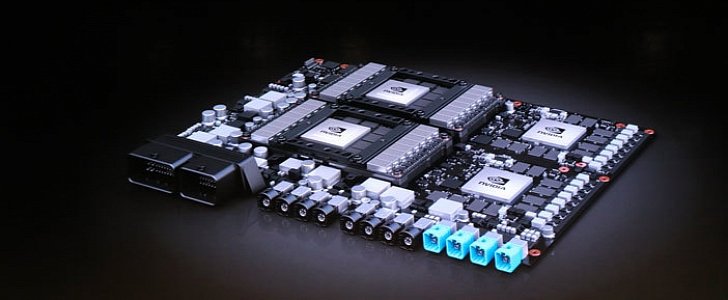If you want to get a sense of our race's technological advancements, this latest computer platform from NVIDIA is the best way to do it. Roughly the size of a license plate, the PX Pegasus is capable of dealing with a tremendous volume of data, one that would have required an entire building a few decades ago.
Coming to replace the NVIDIA PX 2 in the second part of 2018, the Pegasus is capable of dealing with 320 trillion operations per second - over ten times more than the outgoing model which was estimated at 30 trillion. If you think that's a bit of overkill, NVIDIA would like to disagree.
With most future autonomous vehicles relying on a variety of sensors - LIDAR, Radar, video cameras, and ultrasonic - the amount of data these generate is hard to imagine. We're talking one terabyte per second here, with every single of those bytes potentially making the difference between a safe journey or a crash.
NVIDIA says the PX Pegasus will easily deal with this onslaught of information while also sucking up less power than its predecessor. "After the first generation platform, we realized we needed a lot more performance," said Danny Shapiro, director of automotive at NVIDIA, quoted by Automotive News. "This is a true supercomputer for the car."
Of course, not everybody agrees with NVIDIA on the processing power necessary for Level 5 autonomy. Tesla is one of the companies that use the PX 2 platform in its vehicles already, and Elon Musk has said on numerous occasions he thinks the hardware in the vehicles currently on sale is enough to enable complete self-driving capabilities. However, he is alone in this assertion, and some industry voices have begun openly criticizing his view.
The PX Pegasus uses four high-performance AI processors - two of NVIDIA's latest Xavier system-on-a-chip processors featuring an embedded GPU and two next-gen GPUs designed specifically for accelerating deep learning and computer vision algorithms.
It would seem that strictly on the hardware basis, the future of autonomous driving is in good hands. All that remains is for the hundreds of companies involved in cracking this tough nut up to develop the necessary software to go with it.
With most future autonomous vehicles relying on a variety of sensors - LIDAR, Radar, video cameras, and ultrasonic - the amount of data these generate is hard to imagine. We're talking one terabyte per second here, with every single of those bytes potentially making the difference between a safe journey or a crash.
NVIDIA says the PX Pegasus will easily deal with this onslaught of information while also sucking up less power than its predecessor. "After the first generation platform, we realized we needed a lot more performance," said Danny Shapiro, director of automotive at NVIDIA, quoted by Automotive News. "This is a true supercomputer for the car."
Of course, not everybody agrees with NVIDIA on the processing power necessary for Level 5 autonomy. Tesla is one of the companies that use the PX 2 platform in its vehicles already, and Elon Musk has said on numerous occasions he thinks the hardware in the vehicles currently on sale is enough to enable complete self-driving capabilities. However, he is alone in this assertion, and some industry voices have begun openly criticizing his view.
The PX Pegasus uses four high-performance AI processors - two of NVIDIA's latest Xavier system-on-a-chip processors featuring an embedded GPU and two next-gen GPUs designed specifically for accelerating deep learning and computer vision algorithms.
It would seem that strictly on the hardware basis, the future of autonomous driving is in good hands. All that remains is for the hundreds of companies involved in cracking this tough nut up to develop the necessary software to go with it.

